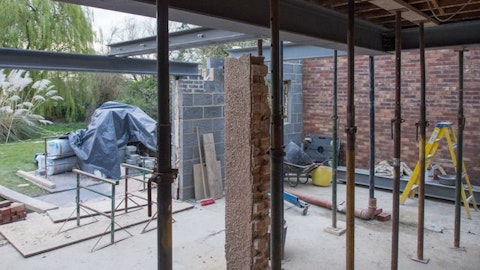Katie Smith: I don’t have the specific number of lots that are going to be finished that aren’t under contract right now, I can probably get that for you, I have to check. But we definitely do have stuff that’s under development that’s not been put under contract yet. In a Forestar sourced project, we aim to have those under contract anywhere from three to six months before delivery. And so there’s definitely still opportunity to put stuff under contract that’s going to close in the back half of the year.
Carl Reichardt: And then last question. You did another deal with a lot banker who’s working with your largest customer. And I’m curious about whether or not that’s a potential growth area for you, whether a lot banker would be working with Horton or not? We certainly talked to plenty who are trying to deploy more capital and looking for opportunities. Can you talk about what that opportunity might be? And then I should [indiscernible] on to that also because I always ask about single family rental and how that business looks if it looks interesting at all, or is that still sort of a one-off?
Katie Smith: I’ll start and I’ll let somebody else chime in if they need to. But I mean, as far as the opportunity with land bankers, it’s not really our decision. We’re not marketing our loss to land bankers. But if one of our customers wants to use a land banker to step in as an intermediary, we’re completely fine with that. It just enhances our capital efficiency and get that inventory off of our balance sheet. So we’re pretty indifferent if there’s a land banker that’s stepping in on behalf of a builder as long as we have all of the checks and balances in place.
Andy Oxley: And as it relates to the part of your question on built for rent, yes, we do think that, that is a sustainable part of our business. If we can have portions of a larger community, which we could improve our pace through selling to a customer that has built for rent components or multifamily components, that’s something that we would absolutely entertain.
Operator: The next question comes from Anthony Pettinari with Citigroup.
Asher Sohnen: This is Asher Sohnen on for Anthony. I think you talked in the past about the capital structure offering competitive advantage. But I’m just wondering, have you seen any concrete kind of like maybe opportunities in the land market come about or any sort of like concrete evidence does it sort of come in to fruition or maybe that will take a little bit longer?
Jim Allen: We’re not seeing any really concrete evidence. What we do see is it does give us a little bit more of a competitive advantage, having the liquidity at hand, competing against another developer. And at times to the other builders are using that developer in a much smaller fashion than they’re using us. They know that we have the liquidity and they’d rather look to us to develop the lots versus the other, let’s call it, local or regional developer. There has been times to where maybe that developer gets into a capital constraint on the following phase and so some builders will look to us to see if we can step in and purchase that additional phase to keep — prevent them from gapping on their home sales.
Asher Sohnen: And then just separately, obviously, you’re not guiding to gross margins for the year. But I’m just wondering, I think previously we talked about increased Forestar sourced lots driving kind of a gross margin headwind. Are you sort of seeing that drive — tailwind rather, are you seeing that tailwind kind of materialize in 2024, is that maybe more of a 2025 story?
Jim Allen: Well, we could see in ’24, definitely, we’re — the Forestar sourced lots does give us more optionality, I guess, with the project. I don’t know that we’ll see. I mean we have seen significant increases in development costs as well. So I don’t know that we’re going to continue to see increased margins as a result of that, because we’re always trying to match price and pace or balance price and pace to improve our returns. So it’s really not just about the sales price or margin, it’s really more about our returns.
Operator: [Operator Instructions] Next question comes from Mike Rehaut with JPMorgan.
Doug Wardlaw: Doug Wardlaw on for Mike. I was wondering if you could kind of speak to any potential regional trends you’ve seen over the recent months, especially with the kind of rate volatility that we’ve experienced, or there’s been any particular regions where you’ve seen strength or particular weakness?
Mark Walker: Not that we’ve seen in particular weakness. Texas and Florida remains strong for us, it’s been a strong hold for a long time.
Doug Wardlaw: And then in terms of, you guys touched on difficulty with municipalities and getting approval there. Is there any kind of vision moving forward where you see that easing up a tad, or is that something that you expect to be a problem for the business moving forward, I guess, for the foreseeable future in 2024?
Mark Walker: Historically, it’s always been a challenge. It’s been delayed even further within past 12 to 24 months, a lot of it’s turnover within those departments themselves. You get some subs that are less experienced that are now in that role versus more season experience. It’s a daily battle, help the feel with our folks bit like — anyway, I’ll refrain from saying that. But I don’t know that’s going to ease up anytime in the foreseeable future. But again, I think it’s market-to-market in terms of where we’re seeing those governmental delays, some areas, we see it, some we don’t. So really fluctuation across the United States.




